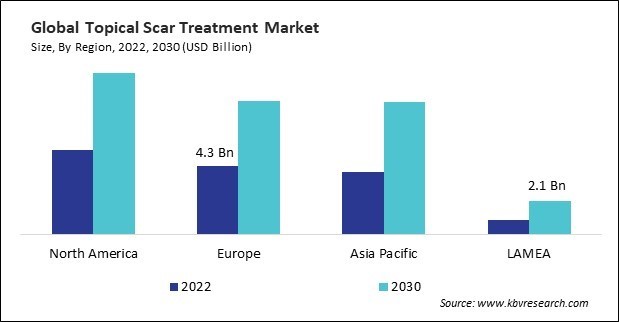According to a new report, published by KBV research, The Global Topical Scar Treatment Market size is expected to reach $28.9 billion by 2030, rising at a market growth of 9.3% CAGR during the forecast period.
Silicone-based products have been widely used in scar treatment. Innovations in silicone gel and sheeting formulations aim to enhance ease of use, comfort, and efficacy in reducing the appearance of scars. Some innovations focus on developing scar treatment products using biodegradable and bioactive materials. These materials are designed to interact with the body’s natural healing processes, promoting tissue regeneration and minimizing scarring. Smart patches and dressings with technology to release active ingredients are gradually being explored.

The primary goal of topical scar treatments is to reduce the visibility of scars. These treatments often work by promoting skin regeneration and minimizing discoloration. Many scar treatments include moisturizing agents to keep the skin hydrated. Proper hydration is essential for optimal wound healing and may improve scar appearance. Ingredients like vitamin C and certain botanical extracts can help reduce hyperpigmentation and minimize discoloration associated with scars, creating a more even skin tone.
The Clinics segment would exhibit a CAGR of 9.7% during (2023 - 2030). Clinics frequently incorporate topical scar treatments as part of combination therapies. This may involve using multiple modalities such as lasers, microdermabrasion, or injectable treatments to achieve comprehensive scar reduction. Clinics often focus on preventive scar management, especially in the context of aesthetic procedures or surgeries. Topical scar treatments may be recommended to minimize scarring before it becomes more pronounced.
The Atrophic Scars segment is generating highest revenue in the Global Topical Scar Treatment Market by Scar Type in 2022; thereby, achieving a market value of $10.8 billion by 2030. Topical treatments for atrophic scars may contain ingredients that enhance skin elasticity. This can help reduce the sunken appearance often associated with atrophic scars, improving the scar’s appearance overall. Innovations in skincare research have led to the inclusion of advanced active ingredients in topical scar treatments. These ingredients may offer targeted benefits for atrophic scars, such as improving skin tone and promoting a smoother surface.
The Gels segment is experiencing a CAGR of 9.5% during (2023 - 2030). Gels are often formulated for quick absorption into the skin. This property allows active ingredients to penetrate the scar tissue efficiently, promoting faster results than other formulations. Gels typically have a non-greasy and lightweight texture. This characteristic is appreciated by individuals who prefer a product that doesn’t leave a heavy or oily residue on the skin. Gels are generally well-tolerated by various skin types, including oily or acne-prone skin. They are often non-comedogenic, reducing the risk of clogging pores.
Full Report: https://www.kbvresearch.com/topical-scar-treatment-market/
The North America region dominated the Global Topical Scar Treatment Market by Region in 2022, and would continue to be a dominant market till 2030; thereby, achieving a market value of $10.1 billion by 2030. The Europe region is anticipated to grow at a CAGR of 8.9% during (2023 - 2030). Additionally, The Asia Pacific region would witness a CAGR of 10.1% during (2023 - 2030).
By End-use
By Scar Type
By Product
By Geography
 Unique Offerings
Unique Offerings